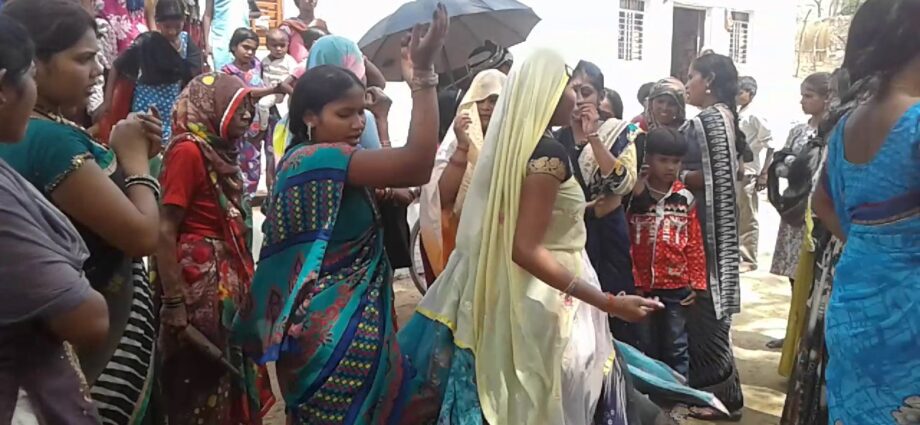In the parts of central India where I was born, there is a marriage ritual called Khoiya. A single experience of Khoiya would tell anyone not only how open our culture was to alternate behavior, but also that how beautifully it incorporated seemingly opposite cultural mores and customs into one tradition. The fact that most social anthropologists do not make any reference to Khoiya and keep on repeating the same categories, identity markers, class and gender conflicts that they are programmed to do, tells us that they have never actually tried to see India with impartial eyes and deep commitment.
Khoiya is a social marital tradition. There is not much about it that is found in literature. Until I was a kid, in most marriages, even in the city the women would not go in a Baraat. Also, in those times, the Baraat went the traditional way. The groom’s party went to the bride’s place and not the other way around which has become the norm now.
This was because cross country, the Baraat party usually went in bullock carts, through open fields, semi forests and ravines. Marriage parties were often looted and so it was not only risky but lethal to take women in Baraat. This tradition became dominant even in cities.
What I am about to discuss, is not the Baraat or what happened at the bride’s place when the Baraat reached there. I am telling you what happened at the groom’s place when all the adult men had left and only women and children were left.
The fear which led the marriage party not take the women along with them, also plagued the groom’s household when all the men had left. There was the danger that finding only women in the house, thieves might break in. and so, the women played a game of charade between themselves. In that charade the women would dress and act like men, often also speaking in heavy and deep voices. They would act like men, to make it sound to the possible thieve lurking outside the gates of the house that the house was still full of men.
What is interesting is the stuff of the conversation. It was often almost pure sexual innuendo, often breaking out into explicit and downright vulgar sexual talk. The point was to make it appear that the most virile of men were left at home! To kick it up one notch, in many societies, the women would store liquor beforehand and would get drunk on Khoiya, making them even bolder and even more explicitly sexual in conversation. There would often be playacting where explicit sexual acts would be reciprocated.
Any men who ventured even near anywhere where Khoiya was held would be mercilessly beaten. Often the secret parts were targeted.
There are many other rituals which are similar in content. In many jatis, in many regions, before the marriage of the girl, the bride’s mother, along with her friends would go around the mohalla, asking for financial help and other help in kind. What is interesting is the method in which they would do it. They would sing lewd songs with such an explicit content that I can’t reproduce them here, much as I want to. In short, most often in these songs, the sexual organs would be talking to each other. The point was to make the ‘higher class’ cough up great sum in shame.
Compare this image of Hindu society with the image that is repeated ad nauseum in the narratives of anthropologists and sociologists who are working on India. Cramming the Marxist themes about class conflict, gender discrimination and caste discrimination in India, they portray an image of India so different from what it actually is that it bears no resemblance to reality.
But are they completely wrong? Was India always so sexually explicit and free in sexual mores and customs? Or was it very conservative and orthodox as the anthropologists and sociologists claim?
The answer is Multiple Value Systems. India never believed in a Universal Value system or having one morality for every Varna or every Jati. Traditions and customs differed widely across regions, jatis and Varnas. while in Brahmin communities and in some Vaishya communities you did find very orthodox and puritan norms about sexual behavior, it was not so in Kshatriya and other communities. While in Kshatriya communities it was often only men who had great sexual freedom, in communities which were termed as Shudras before and now as SCs, STs and many OBCs, women had as much, and sometimes even more sexual freedom than men.
It was very common for a woman to take more than one husband in her life. And the reason would not just be the death of the first one. Sometimes, women just left one husband and took another and sometimes the cause would explicitly be stated as sexual dissatisfaction. There was a great saying in that community which roughly translated as: “Brothers are more important than husbands. You can take another husband if one dies, but where will you find another brother, if your own brother dies?”
Khoiya is also not a universal tradition. Khoiya is not common in all jatis and Varnas. It is most common in what are classified as SCs, STs and OBCs, and not as common or at least not as explicitly sexual in content in the Brahmin and Vaishya communities.
On one hand, there were the Brahmin communities who lived very orthodox and puritan lives, disciplining their minds and bodies in the most rigorous of ways. True, their lifestyle was considered high and ideal, but it was in no way forced upon others. The Kshatriyas consumed meat and liquor, had many wives. The Shudras lived a life which was free in its sexual mores and customs, along with many other aspects of life. They were bound by very few rules in marriage, in food and in dress. They lived as they wanted, enjoying the life as it came.
But consequently they did not have great positions of power too. It was taken to heart in traditional India that with great power comes great responsibility. The most powerful communities of India had the stringiest of rules and regulations. Most of the Smritis talk about that. The most powerless communities were empowered in the sense that they could do anything they wanted, within their own communities. Their lifestyle would not be considered exemplary. But they thoroughly enjoyed their lives in pretty much the modern way, except the responsibility part. Life was give and take. Power came with sacrifice, discipline and Puritanism. Enjoyment or ‘fun’ came with lack of political power.
Anyone who sees India through one lens, let alone so patently false as Marxist, is bound to straightjacket India into one or the other narrative: extremely orthodox or sexually emancipated. The reality, as always, but more so in the case of a traditional society like India, is more complex, defying any categories, and most importantly, hiding the advantages of a multiple value system.
Published earlier in Facebook by Pankaj Saxena on 19.04.2020 and 21.04.2022.
![]()
- IT IS AN ASYMMETRIC WAR - June 29, 2022
- Sexual Morality and Multiple Value Systems in India - April 21, 2022
- Sri Rama The Universal Human Hero - April 10, 2022


